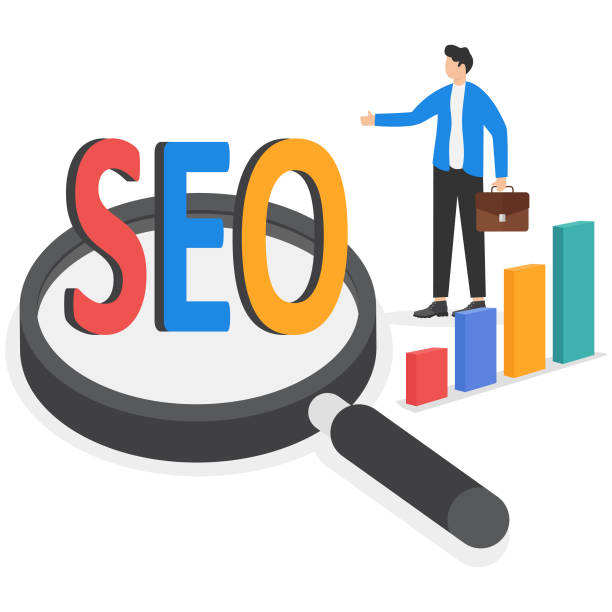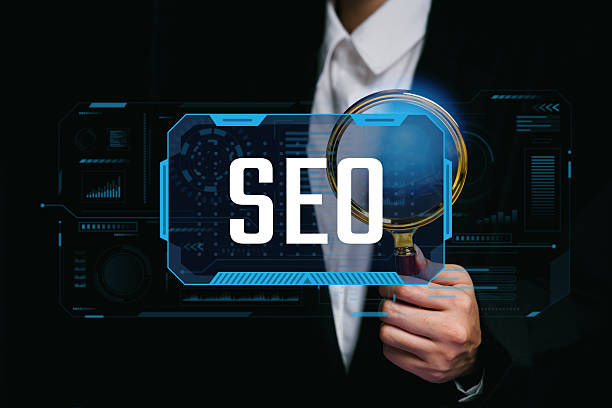What is Internal SEO and Why is it Important?
![]()
What is Internal SEO?
Internal SEO, also known as On-Page SEO, is a set of techniques and actions performed within your website to improve your site’s ranking in Google search results and other search engines.
These techniques include optimizing content, site structure, keywords, title and meta description tags, and internal links.
The main goal of internal SEO is to provide a better and more optimized user experience for visitors and search engines.
Why is Internal SEO Important?
The importance of Internal SEO lies in the fact that it helps search engines better understand your site’s content and provide users with the most relevant results.
By performing appropriate optimizations, you can improve your site’s ranking in search results, attract more traffic, and ultimately achieve your business goals.
SEO optimization is a vital process for any business that wants to succeed in the online world.
In other words, Internal SEO helps you answer the following questions:
- How do search engines understand your site?
- Is your content engaging and useful for users?
- Does your site structure help users and search engines easily access the information they need?
By answering these questions and performing the necessary optimizations, you can improve your site’s Internal SEO and improve your ranking in search results.
For more information about #digital_marketing, click here.
Is your company’s website as professional and trustworthy as it should be? Create an online presence that reflects your credibility and attracts more customers with a specialized corporate website design by Rasaweb.
✅ Build a powerful and professional image of your brand
✅ Turn visitors into real customers
⚡ Get a free consultation now!
Keyword Research and Finding the Best Opportunities

Keyword Research
Keyword research is the first step in any successful Internal SEO strategy.
The purpose of this step is to find the words that users use to search for your products or services.
By knowing these words, you can optimize your content based on them and attract more targeted traffic to your site.
How to Find the Right Keywords?
- Identify Main Keywords: Using your knowledge of your business, create a list of main keywords.
These words should be related to your products or services. - Use Keyword Research Tools: There are many tools that help you find relevant and popular keywords.
Some of these tools include Google Keyword Planner, Ahrefs, Semrush, and Moz Keyword Explorer. - Analyze Competitors: Check what keywords your competitors are using.
This information can help you find new opportunities. - Consider Long-Tail Keywords: Long-tail keywords are longer and more specific phrases that users use for more precise searches.
These words usually have less competition and can attract more targeted traffic to your site.
After finding the right keywords, you should use them naturally and purposefully in your content.
Avoid overusing keywords (Keyword Stuffing), as this can harm your site’s ranking.
Effective Internal SEO requires a balance.
Optimizing Titles and Meta Descriptions to Increase Click-Through Rate

Optimizing Titles and Meta Descriptions
Title Tags and Meta Descriptions are two important elements in Internal SEO that are displayed in search results.
Titles are the main title of your page and are displayed at the top of the search result.
Meta descriptions are a summary of your page’s content and are displayed below the title.
How to Optimize Titles and Meta Descriptions?
- Use Keywords: Include your main keywords in the title and meta description.
- Be Attractive and Persuasive: The title and meta description should be attractive and persuasive to encourage users to click on your link.
- Be Concise and Useful: The title and meta description should be concise and useful, providing key information in summary.
In general, the title length should not exceed 60 characters and the meta description length should not exceed 160 characters. - Be Unique: The title and meta description of each page should be unique and accurately describe the content of that page.
Internal SEO is of great importance and should not be ignored.
| Element | Description | Best Practices |
|---|---|---|
| Title Tag | The main title of the page that is displayed in search results. | Includes main keyword, attractive and concise (less than 60 characters) |
| Meta Description | A summary of the page’s content that is displayed below the title in search results. | Attractive, concise (less than 160 characters), includes keyword and encourages clicks |
Optimizing URL Structure for SEO and User Experience

Optimizing URL Structure
The URL (Uniform Resource Locator) structure, or the internet address of your site’s pages, plays an important role in Internal SEO and user experience.
An optimized URL helps search engines better understand the content of the page and helps users easily access the pages they want.
How to Optimize URL Structure?
- Use Keywords: Include your main keywords in the URL.
- Be Short and Concise: The URL should be short and concise, avoiding unnecessary words.
- Use Hyphens (-): Use hyphens to separate words in the URL.
- Avoid Special Characters: Avoid using special characters such as question marks, exclamation marks, etc. in the URL.
- Compatibility with Site Structure: The URL should be compatible with the overall structure of your site and indicate the hierarchy of pages.
For example, instead of using an incomprehensible URL like `example.com/page?id=123`, use an optimized URL like `example.com/blog/seo-internal`.
Internal SEO improves with optimized URL structure.
Are you worried about the low conversion rate of your online store and not getting the sales you want?
Rasaweb is your specialized solution for having a successful online store.
✅ Significant increase in conversion rate and sales
✅ Professional and user-friendly design to satisfy customers
⚡ Ready for a transformation in online sales? Get a free consultation!
The Importance of Site Loading Speed and Solutions to Improve It

The Importance of Site Loading Speed
Site loading speed is one of the important factors in Google ranking and user experience.
Users expect your site’s pages to load quickly, and if a page takes more than a few seconds to load, they may leave your site.
In addition, Google gives a better ranking to sites with high loading speeds.
How to Improve Site Loading Speed?
- Optimize Images: Large, high-quality images can slow down site loading speed.
Optimize your images before uploading them to the site and use appropriate formats such as JPEG or PNG. - Enable Gzip Compression: Gzip compression reduces the size of your site’s files and improves loading speed.
- Use CDN: CDN (Content Delivery Network) is a content distribution network that stores your site’s content on different servers around the world.
By using CDN, users can receive your site’s content from the nearest server and loading speed is improved. - Optimize Code: Optimize the HTML, CSS, and JavaScript code of your site and avoid unnecessary and redundant code.
- Choose a Suitable Hosting: Choosing a quality and high-speed hosting can have a significant impact on your site’s loading speed.
Internal SEO improves with suitable hosting.
Optimizing site loading speed is an ongoing process and should be regularly reviewed and improved.
Optimizing Images for Better SEO and User Experience

Optimizing Images
Images are an important part of website content that can improve user experience and increase the visual appeal of the site.
However, unoptimized images can slow down site loading speed and negatively impact Internal SEO.
Optimizing Images for SEO is a vital process.
How to Optimize Images for SEO?
- Choose the Right Format: Use appropriate formats such as JPEG for images with many colors and PNG for images with graphics and text.
- Reduce File Size: Significantly reduce the file size of images without reducing quality.
There are many online tools and image editing software for this. - Use Alt Text: Write a descriptive Alt Text for each image.
Alt Text helps search engines understand the content of the image, and it is displayed to the user if the image does not load. - Properly Name Files: Name image files with descriptive names that include keywords.
For example, instead of using a name like `IMG_1234.jpg`, use a name like `seo-internal-guide.jpg`. - Use Title and Caption: Write descriptive titles and captions for your images.
Optimal Internal SEO is achieved with optimized images.
Using Internal Links to Improve Site Structure and Distribute Ranking

Using Internal Links
Internal links are links that connect different pages of a website.
Using internal links helps to improve site structure, distribute ranking (PageRank), and user experience.
Internal SEO will be incomplete without proper internal linking.
How to Use Internal Links Effectively?
- Link to Relevant Pages: Link to pages that are relevant to the content of the current page.
- Use Proper Anchor Text: Use descriptive anchor text (the text that is linked) that includes keywords.
- Create a Logical Internal Link Structure: Create a logical internal link structure that helps users and search engines easily navigate your site.
- Avoid Broken Links: Identify and fix broken links (links that point to pages that no longer exist).
In general, using internal links is a simple and effective way to improve Internal SEO and user experience.
| Advantage | Description |
|---|---|
| Improving Site Structure | Creating a logical and easy structure for user and search engine navigation |
| Distributing Ranking (PageRank) | Transferring credibility between different pages of the site |
| Improving User Experience | Providing easy access to relevant information |
Optimizing Main Page Content for Target Keywords

Optimizing Main Page Content
The main page content is the heart of Internal SEO.
High-quality, valuable content that is relevant to the target keywords can significantly improve your site’s ranking in search results.
Optimizing page content includes the following:
- Keyword Research: Before you start writing, research your target keywords carefully.
- Using Keywords in Titles and Subtitles: Use your main keywords in the main title (H1) and subtitles (H2, H3, etc.).
- Using Keywords in Body Text: Use your keywords naturally and purposefully in the body text.
Avoid overusing keywords. - Creating High-Quality and Valuable Content: Your content should be useful, informative, and engaging for users.
Avoid providing false or misleading information. - Updating Content: Regularly update your content and add new and relevant information to it.
Remember that your main goal should be to provide an excellent user experience.
If users enjoy your content and get their questions answered, your site’s Internal SEO will also improve.
Are you tired of your company’s website failing to meet your expectations? Design a professional website with Rasaweb that showcases the true face of your business.
✅ Increase attraction of new customers and sales leads
✅ Increase the credibility and trust of your brand with the audience
⚡ Get a free website design consultation!
The Importance of Mobile-Friendly Site and Implementation Solutions

The Importance of Mobile-Friendly
Due to the increasing use of mobile phones for internet searches, having a Mobile-Friendly site is one of the important factors in Internal SEO.
Google gives a better ranking to sites that are optimized for mobile devices.
In addition, a mobile-friendly site provides a better user experience for users who use mobile phones.
How to Make Your Site Mobile-Friendly?
- Use Responsive Design: Responsive design allows your site to automatically adapt to the screen size of the user’s device.
- Optimize Loading Speed: Site loading speed is very important on mobile devices.
Use the loading speed optimization techniques mentioned earlier. - Use Readable Fonts: Use fonts that are easily readable on mobile devices.
- Optimize Images: Optimize your images for mobile devices.
- Test the Site on Different Devices: Test your site on different mobile devices to make sure it is displayed correctly.
Internal SEO and mobile-friendliness are two sides of the same coin.
Your site must be optimized in both areas.
Analysis and Monitoring of Internal SEO Results and Continuous Improvement

Analysis and Monitoring of Internal SEO Results
Internal SEO is an ongoing process and requires continuous analysis and monitoring.
You should regularly review the results of your efforts and make necessary changes if needed.
Analyzing and monitoring the results of Internal SEO includes the following:
- Check Site Ranking in Search Results: Use Rank Tracking Tools to check your site’s ranking for target keywords.
- Analyze Site Traffic: Use Google Analytics to analyze your site’s traffic and see which pages users visit most and how they interact with your site.
- Check Click-Through Rate (CTR): Click-Through Rate (CTR) shows what percentage of users who see your site’s link in search results click on it.
Increasing CTR can help improve your site’s ranking. - Check Bounce Rate: Bounce Rate shows what percentage of users who visit a page leave the site without visiting other pages on your site.
Reducing bounce rate can help improve user experience. - Check Time on Page: Time on Page shows how much time users spend on different pages of your site.
Increasing Time on Page can indicate that your content is engaging and useful for users.
Using this information, you can identify the strengths and weaknesses of your site’s Internal SEO and adjust your strategies accordingly.
Internal SEO is a dynamic process and requires continuous learning and adaptation.
Proper Internal SEO helps you to have a good ranking in Google.
Frequently Asked Questions
| Row | Question | Answer |
|---|---|---|
| 1 | What is Internal SEO (On-Page SEO)? | Internal SEO refers to a set of actions performed inside a website (on its pages) to improve the site’s ranking in search engine results. This includes optimizing content, site structure, and HTML codes. |
| 2 | Why is Internal SEO important? | Internal SEO helps search engines better understand the content of the page and determine whether that page is relevant and valuable for users’ searches. This better understanding leads to a higher ranking. |
| 3 | What is the first and most important step in Internal SEO? | Keyword Research is the most important initial step. By finding the right keywords, you can produce targeted content relevant to users’ needs. |
| 4 | What is the role of the Title Tag in Internal SEO? | The Title Tag is one of the most important ranking factors and should include the main keyword. This tag is displayed in search results as the page title and affects the Click-Through Rate (CTR). |
| 5 | What is the importance of Meta Description? | The Meta Description does not directly affect ranking, but by providing an attractive summary of the page’s content in search results, it can encourage users to click and thus increase the Click-Through Rate (CTR). |
| 6 | Why is the use of Headings (H1, H2, etc.) important in content? | Headings help to structure content and improve readability for users and search engine crawlers. Using keywords in headings also helps search engines better understand the topic. |
| 7 | What does Image Optimization in Internal SEO include? | It includes compressing images to reduce size, using descriptive and relevant file names, and filling the Alt tag (alternative text) with relevant keywords to help search engines understand the content of the image. |
| 8 | What is meant by Internal Linking in Internal SEO? | Internal linking refers to creating links between different pages of a website. This helps to distribute Link Equity, improve user experience, and help search engine crawlers discover new pages. |
| 9 | Why is Page Speed important for Internal SEO? | Page speed is a direct ranking factor and strongly affects user experience. Slow pages can increase the Bounce Rate and reduce user engagement. |
| 10 | What role does Quality Content play in Internal SEO? | High-quality, comprehensive, unique, and valuable content for the user is the core of Internal SEO. This content not only attracts and retains users but also sends positive signals to search engines and helps to improve ranking. |
and other services of Rasa Web Advertising Agency in the field of advertising
Smart Data Analysis: An effective tool to attract customers with the help of marketing automation.
Smart Marketing Automation: A creative platform to improve sales increase with accurate audience targeting.
Smart Marketplace: A creative platform to improve customer behavior analysis with dedicated programming.
Smart Conversion Rate Optimization: A quick and efficient solution for user interaction with a focus on attractive user interface design.
Smart Reportage: An effective tool for managing campaigns with the help of SEO-oriented content strategy.
and more than hundreds of other services in the field of internet advertising, advertising consulting, and organizational solutions
Internet Advertising | Advertising Strategy | Reportage Ad
Resources
Internal SEO Training or On-Page SEO
,What is Internal SEO? On Page SEO Optimization Training
,What is Internal SEO? Comprehensive Guide to On Page SEO Optimization in 2024
,On-Page SEO: The Definitive Guide
? Ready to transform your business in the digital world? Rasaweb Advertising Digital Agency, with expertise in various fields including Professional Website Design, SEO, and Social Media Management, paves the way for your growth and success.
📍 Tehran, Mirdamad Street, next to Central Bank, South Kazerun Alley, Ramin Alley No. 6




